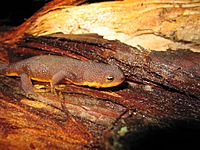Coastal Range newt facts for kids
Quick facts for kids Costal Range Newt |
|
|---|---|
 |
|
| Scientific classification | |
| Kingdom: | |
| Phylum: | |
| Class: | |
| Order: | |
| Family: | |
| Genus: | |
| Species: |
T. torosa
|
| Subspecies: |
T. t. torosa
|
| Trinomial name | |
| Taricha torosa torosa |
|
The Costal Range Newt (scientific name: Taricha torosa torosa) is a fascinating amphibian that calls California home. It is a specific type, or subspecies, of the California newt. These amazing creatures are part of the salamander family. They spend their lives both on land and in water, making them unique residents of California's natural areas.
Contents
What is a Costal Range Newt?
The Costal Range Newt is a small, brownish-orange amphibian. It has rough, bumpy skin. Its belly is usually a bright orange or yellow color. This bright color is a warning sign to predators. Newts are known for their ability to live in two different environments. They can breathe through their skin and lungs.
Where Do They Live?
These newts are found in specific parts of California. You can spot them in the California Coast Ranges. They also live as far south as San Diego, California. They prefer habitats with forests or woodlands. You'll often find them near streams, ponds, or slow-moving water. This is because they need water for breeding and for their young to grow.
What Do They Look Like?
Costal Range Newts are usually about 5 to 8 inches (13 to 20 cm) long. This includes their tail. Their back and sides are a dull brown or olive color. Their underside is a striking orange or yellow. This bright color is called aposematic coloration. It tells other animals that the newt might be dangerous to eat. Their skin feels dry and rough when they are on land. But it becomes smooth when they are in water.
Life Cycle of a Newt
Newts have an interesting life cycle. It involves both water and land.
Breeding Season
Adult Costal Range Newts usually return to water to breed. This often happens during the rainy season. They look for calm ponds or slow parts of streams. The male newts will try to attract females. They perform a special "dance" in the water.
Eggs and Larvae
Female newts lay their eggs in the water. The eggs are usually attached to underwater plants or rocks. The eggs hatch into tiny larvae. These larvae look like small fish. They have feathery gills on the outside of their heads. These gills help them breathe underwater. The larvae live entirely in the water. They eat tiny aquatic creatures.
Metamorphosis
After a few months, the larvae go through a big change. This change is called metamorphosis. They lose their gills and develop lungs. Their bodies also change shape. They become more like adult newts. Once they complete metamorphosis, they leave the water. They then live on land for several years.
Adult Life
Adult newts spend most of their time on land. They hide under logs, rocks, or in leaf litter. They come out to hunt for food. They return to the water only during the breeding season. Some adults might stay in the water for longer periods. This depends on the availability of food and shelter.
What Do They Eat?
Costal Range Newts are carnivores. This means they eat other animals.
On Land
When they are on land, they hunt for small invertebrates. Their diet includes worms, slugs, and insects. They use their sticky tongues to catch their prey. They are important predators in their ecosystem.
In Water
When they are in the water, they eat different things. They might eat small aquatic insects. They also eat tiny crustaceans or other small water creatures. Larvae eat even smaller organisms.
Defense Mechanisms
Costal Range Newts have a powerful defense mechanism. Their skin produces a strong poison.
Tetrodotoxin
This poison is called tetrodotoxin. It is the same poison found in pufferfish. This poison is very dangerous if eaten. It can make predators very sick. It can even be deadly. This is why their bright belly color is a warning. Most animals learn to avoid eating newts.
Safety for Humans
It's important to know that newts are not dangerous to touch. The poison is only harmful if it gets into your mouth or bloodstream. Always wash your hands thoroughly after touching a newt. It's best to observe them without handling them. This keeps both you and the newt safe.
Conservation and Threats
Like many amphibians, Costal Range Newts face several threats.
Habitat Loss
One of the biggest threats is habitat loss. Their homes are being destroyed or changed. This happens because of human development. Roads, buildings, and farms take away their natural spaces. Pollution of water sources also harms them.
Climate Change
Climate change can also affect newts. Changes in rainfall patterns can dry up their breeding ponds. Warmer temperatures can also stress them. This makes it harder for them to survive.
Protecting Newts
It's important to protect these amazing creatures. We can help by preserving their habitats. This means protecting forests and clean water sources. Not disturbing them during their breeding season is also important. Learning about newts helps us understand why they are valuable. Every creature plays a role in a healthy ecosystem.

